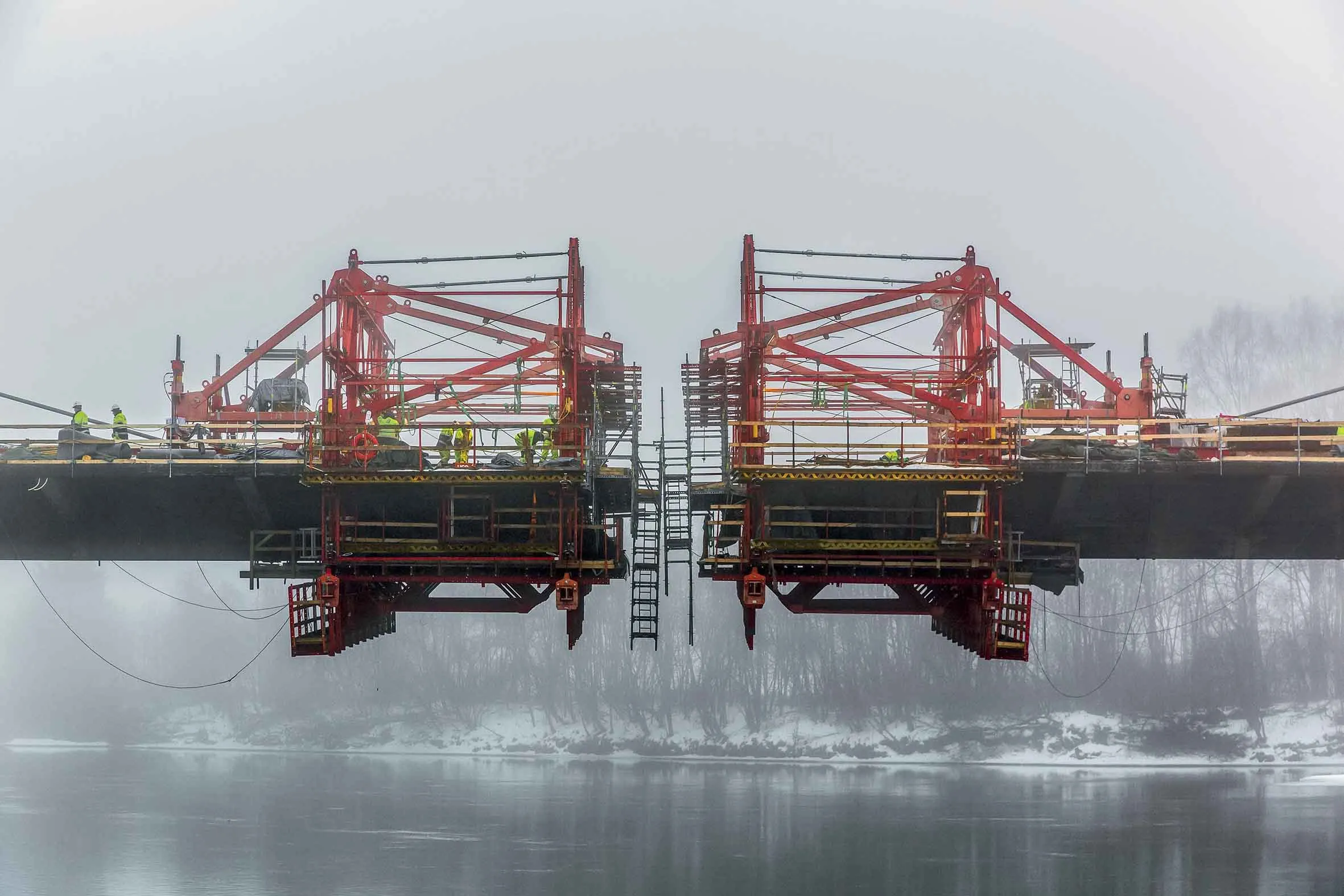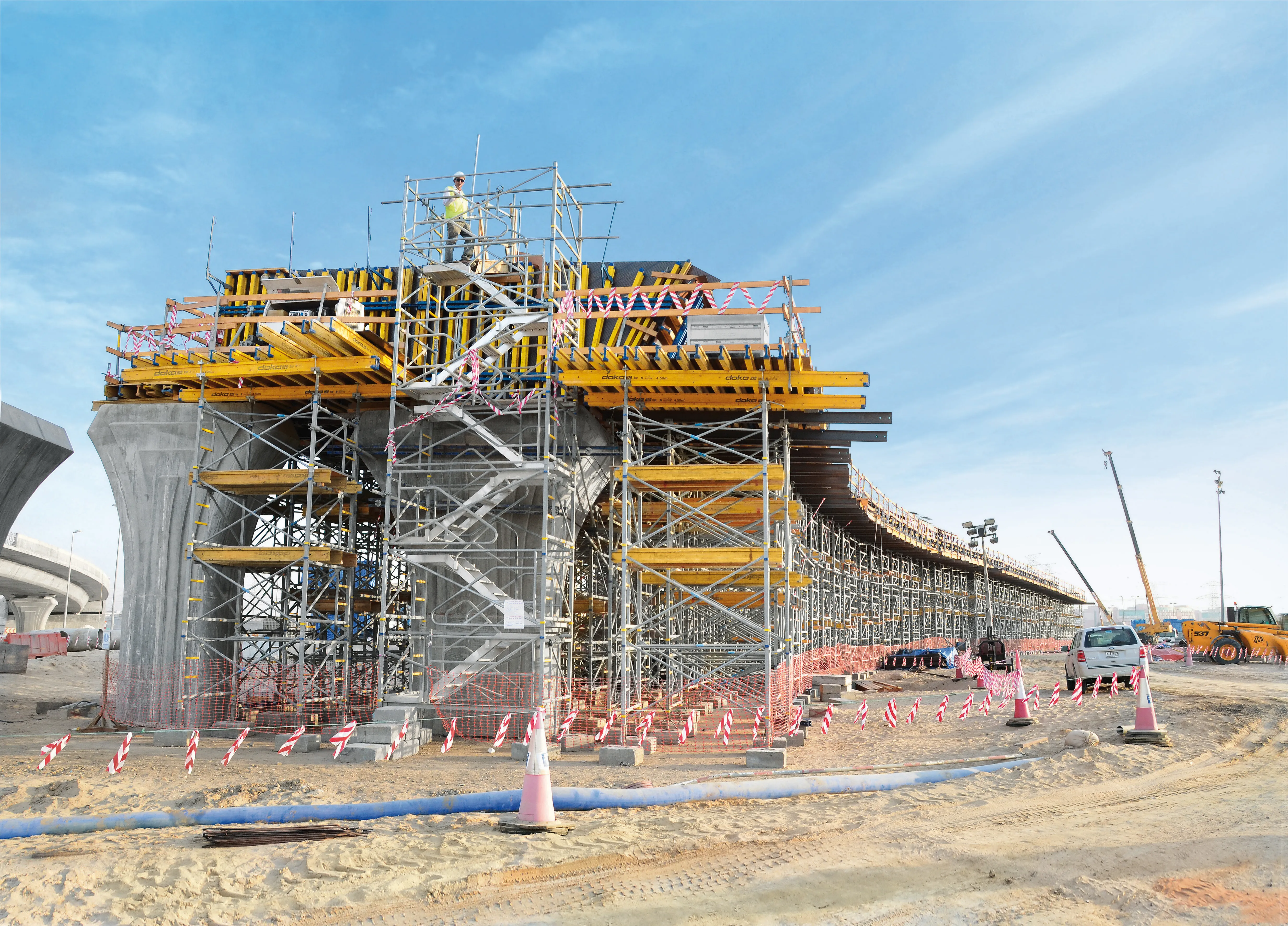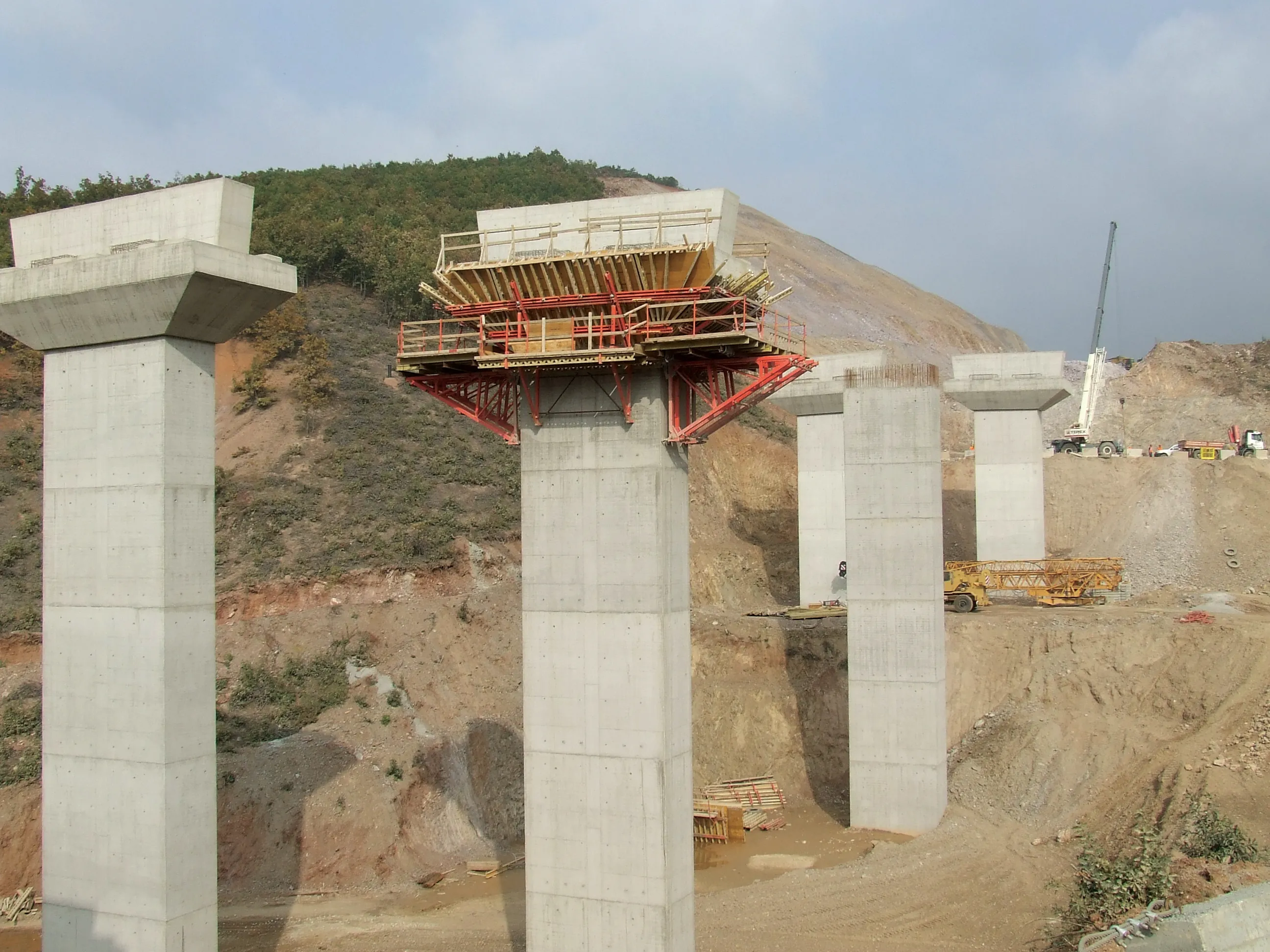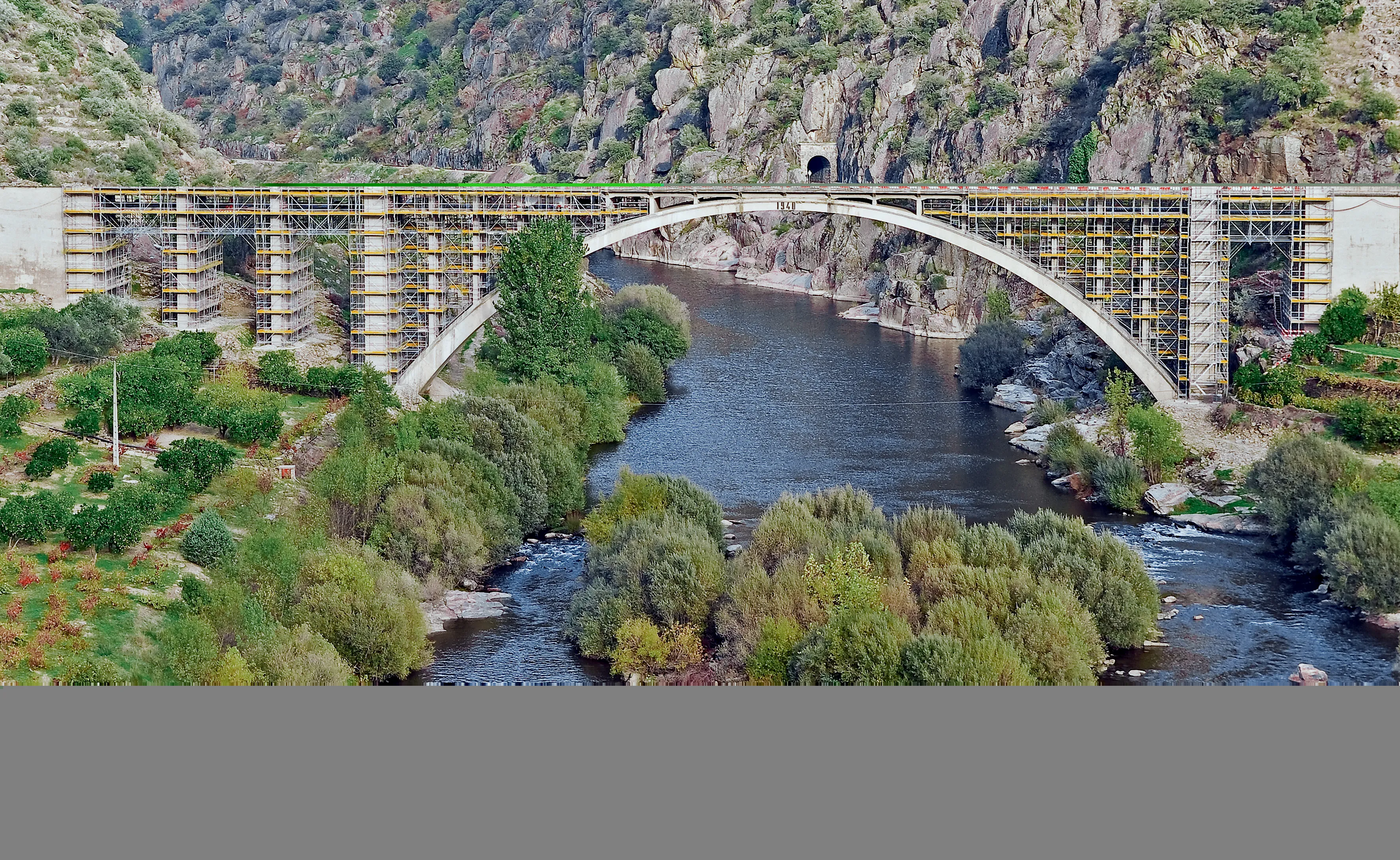Innovative solutions are being applied to the construction of bridge structures as Patrick Smith reports. RMD Kwikform Iberica has engineered and supplied specialist formwork and falsework for construction of the much-needed Monteporreiro Viaduct in northern Spain. The viaduct will connect Monteporreiro with the Benedictine Monastery of San Bieito Lérez on the other side of the river, and in the process will ease congestion in the nearby town of Pontevedra, diverting some 5,000 vehicles/day.
February 20, 2012
Read time: 6 mins
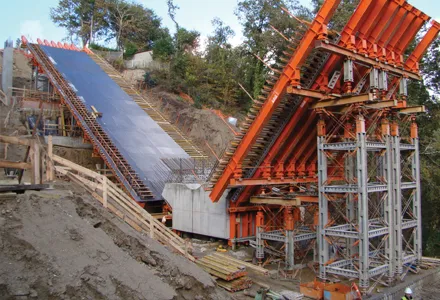
Innovative solutions are being applied to the construction of bridge structures as Patrick Smith reports
RMD Kwikform Iberica was chosen by sub-contractor Construgomes to supply the formwork and falsework for construction of the twin
V-shaped piers and the bridge decks directly above them. It supplied approximately 1,500tonnes of equipment to the project.
Each of the pier arms were 5.5m wide, between 1.132-2m thick and varied in length from 22-36m, and to add to the challenge each pier was set at a different angle, meaning a truly bespoke design and construction was required.
"To support the formwork to be used for the piers we designed and constructed a falsework system using heavy duty Megashor towers and inclined steel beams. The beams were then anchored to the abutments with a tie, designed specifically for this project. This tie allowed us to compensate for both the extremely high traction forces on the inclined arms of the pier and the vertical load transferred to Megashor towers that occur with the inclined concreting of the piers. Without the specially designed ties this would have been a very difficult build indeed," says Alberto Aldama, engineer at RMD Kwikform Iberica.
"The formwork itself, which was supported by the falsework, was constructed using a Superslim Soldier and T200 timber beam configuration, faced Phenolic lining. The piers were then struck in 4m long sections." For the deck section it was decided to use a modular formwork table solution that could be pre-erected on the ground and then craned into position fully assembled.
These were constructed from an arrangement of Superslim Soldiers and T200 beams, again using Phenolic lining, and this arrangement was then used to form the 64.12m deck section above pier 1 and the 54.36m section above pier 2.
The challenge for the engineers when constructing the deck sections came with the variable depth throughout the length of each section.
"For the deck we wanted to use a single formwork design that could run the entire length of each deck section.
"To accommodate the variable depth of the deck we constructed the formwork with a double interior bottom, this being transversal in the areas where there is a little change in inclination and longitudinal in areas of steep inclination. This allowed us to effectively adjust the formwork in situ to meet the required variations throughout the bottom of the deck, saving both time and money," says Aldama.
Supporting the formwork configuration was a falsework structure constructed from Megashor towers, topped with steel beams, although this presented its own challenges.
"Because the construction of the piers had left very little room at the base for us to anchor the Megashor towers we had to create a solution that would be effective with the limited ground space available to us.
"Consequently we placed Megashor towers either side of the individual pier structures, this left us with an 8.5m gap between the two arms of the pier in which we had to provide support. To overcome this we supplied specially fabricated triple web RMD800 beams to be used as spreader beams to support the main beams above. We then used longitudinal and transverse interconnecting Megashor props to provide additional support across all the towers, allowing the number of supports in the structure to be optimised, resulting in the towers being less affected by the inherent horizontal loads."
The bridge is scheduled to be opened to traffic in June 2011.
Rio Sordo Bridge
The company says that through the use of rentable system components taken from the VARIOKIT engineering construction kit, PERI was able to develop a cost-effective solution for the superstructure formwork and shoring.
The A4 motorway in northern Portugal stretches eastwards from Porto on the Atlantic coast to Bragança on the Spanish border.
The route through the Marão Mountains requires construction of a new motorway bridge crossing the Sordo Valley near Vila Real. The 412m long, five-section structure has two separate superstructures.
The almost 20m wide and 3.6m high prestressed concrete hollow box girders are being realised using two different construction methods: the three middle bridge spans with the balanced cantilever method; and the respective edge spans formed on PERI shoring.
"PERI's Portuguese engineers provided a formwork and scaffolding solution for the construction of all structural components: VARIO elements and CB brackets formed the climbing formwork for the bridge piers; for the pier tables, suspended SB brace frames served as load-bearing scaffold while the VARIO girder wall formwork system was used for forming the starters for the balanced cantilever," says PERI.
The superstructure formwork and falsework for the four edge sections are based on the PERI VARIOKIT engineering construction kit, and the superstructure width increases from 16m to 19.4m were taken into consideration during the planning phase.
As falsework, the contractor is using VARIOKIT VST (VARIOKIT Shoring Tower) heavy-duty shoring towers, 6m to 30m high, with load-bearing capacities of up to 2,500kN each.
The VST towers are erected as four-legged individual structures which support the 72m long superstructure formwork at defined load application points with axis spacings of between 10m and 24m. Transversely, the tower measures 2m in each case, longitudinally between 2m and 7.5m, depending on topographical and static requirements. In those areas which are subjected to particularly high loads, additional legs with axis spacings of 37.5cm provide an increase in the load-bearing capacities.
The partial adaptation to the loads which are to be carried considerably reduces material requirements along with minimising the erection work needed for the falsework. Due to the modular design of the VST towers, it is possible to adapt the load-carrying system to suit all construction site requirements. Adaptations due to the bridge piers have been possible with system components.
Assembly of the falsework was carried out using variable frame arrangements with heights ranging from 1.25m to 10.25m, and these are delivered to the construction site as pre-assembled units and then further extended on the ground to form tower segments.
"A crane was used for erection of the towers and height extensions. Safe PERI UP working platforms are used to ensure accurate positioning along with fixing in place with bolts and pins. Together with the heavy-duty shoring towers, these are continuously added to as required," says PERI.
The new VST heavy-duty shoring tower serves as load-bearing scaffold in large bridge construction and civil engineering projects, and as a modular system it can be assembled flexibly for heights up to 40m as frame arrangements, towers or shoring tower frames.


